Plant Profiles dive deep on one plant variety. They are meant to provide you with enough information to make good growing decisions. A desire to grow gorgeous flowers is one thing. However, discerning if a particular plant is right for you and your climate is a whole other ballgame.
My intention here is to give you as much practical information to make these decisions. However, I’m going one step further and taking you completely behind the scenes to share exactly what has worked for us as well. For this reason, Plant Profiles are broken up into what I’m calling the “Nuts and Bolts (N&B)” and “Behind the Scenes (BTS).”
If you haven’t already, please be sure to read the FFY Introduction to learn more about how Plant Profiles are organized.

Primary Sources
The primary sources for the N&B portion come from:
- Postharvest Handling of Cut Flowers and Greens: A Practical Guide for Commercial Growers, Wholesalers & Retailers (Dole, Stamps, Carlson, et al).
- Specialty Cut Flowers, 2nd Edition, Revised & Enlarged (SCF): Industry standard for both new and experienced growers on the production of annuals, perennials, bulbs, and woody plants for fresh and dried cut flowers (Allan M. Amritage and Judy M. Laushman)
- Johnny’s Selected Seeds (Johnny’s): Johnny’s has been in the business for 50 years, with a research farm dedicated to finding the best seeds and tools for farmers and gardeners
- BOSTON Ornamental Terminal Prices. Specialty Crops Market News Federal – State Market News Service, USDA (as of 14-FEB-2023
- The Cut Flower Handbook: Select, Plant, Grow, and Harvest Gorgeous Blooms (Ziegler & Graven)
Zone Considerations
- Johnny’s Selected Seeds research farm is located in Zone 5a Maine
- Lisa Mason Ziegler’s farm, The Gardener’s Workshop, is located in Zone 7a/8b Virginia
- My farm, Petal Back Farm, is located in Zone 4b Wisconsin
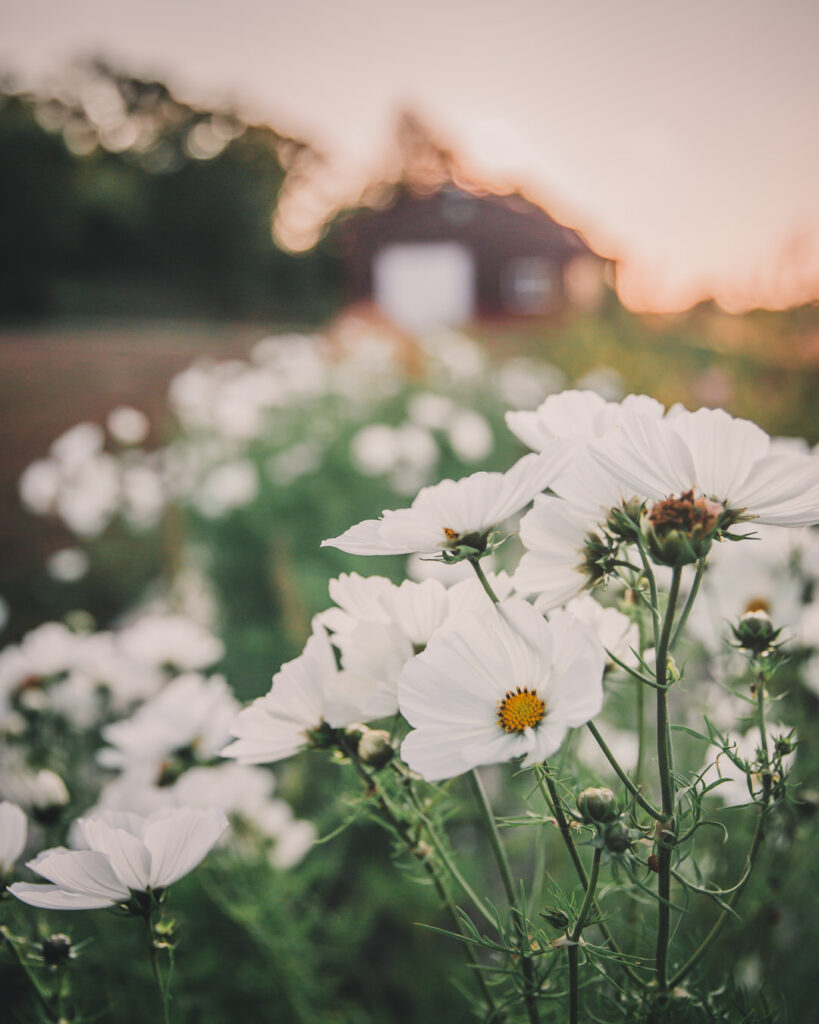
General Information: N&B
Latin Name Name: Cosmos bipinnatus
Common Name: Cosmos
Origin: Mexico
Days to Maturity: 75–90 days
Life Cycle: Annual
Spacing: 6–15″
Height: 1.5’–6′
Cosmos are native to Mexico, preferring drier soil and humid weather, but are relatively easy to grow, prolific, and pest/disease resistant (SCF). Depending on the cultivar, blooms may be single, semi-double, fully double, or tubular shaped with fluted edges (Johnny’s).
General Information: BTS
Although harvesting cosmos is not my favorite, it’s absolutely iconic. A single planting will crank out romantic blooms, overcoming the harvesting drawback. Aesthetically, it has the sweetest vibe and I love it for design work, especially that natural, garden style. Although it’s stems are tedious to harvest and clean, they are so easy to weave into arrangements and bulk up bouquets. Because they do not have a long vase life, they are usually only found locally, giving farmer-florists and edge on the market with florists.
On top of that, cosmos are prolific, easy to grow, and pest/disease resistant. Of their few shortcomings, there are a few tricks to getting them right. Longer vase life can be achieved by harvesting at the proper stage. Planting during the right times and understanding fertilizer requirements leads to prolific blooms. Longer stems are achieved with proper pinching techniques (and variety selection). And by choosing the right varieties, harvesting can be easier. These are all covered here in this profile.
What I love most about cosmos as a cut flower:
- Easy to grow
- Playful stems
- Fabulous for design (especially garden style)
- Popular with customers
- Extremely prolific (come-and-cut)
- Attracts pollinators
- Pest/disease resistant
But every rose has its thorn, right? Potential shortcomings:
- Tedious to harvest (but some varieties are easier than others)
- Shorter vase life compared to other cut flowers (though there are some harvest tricks)
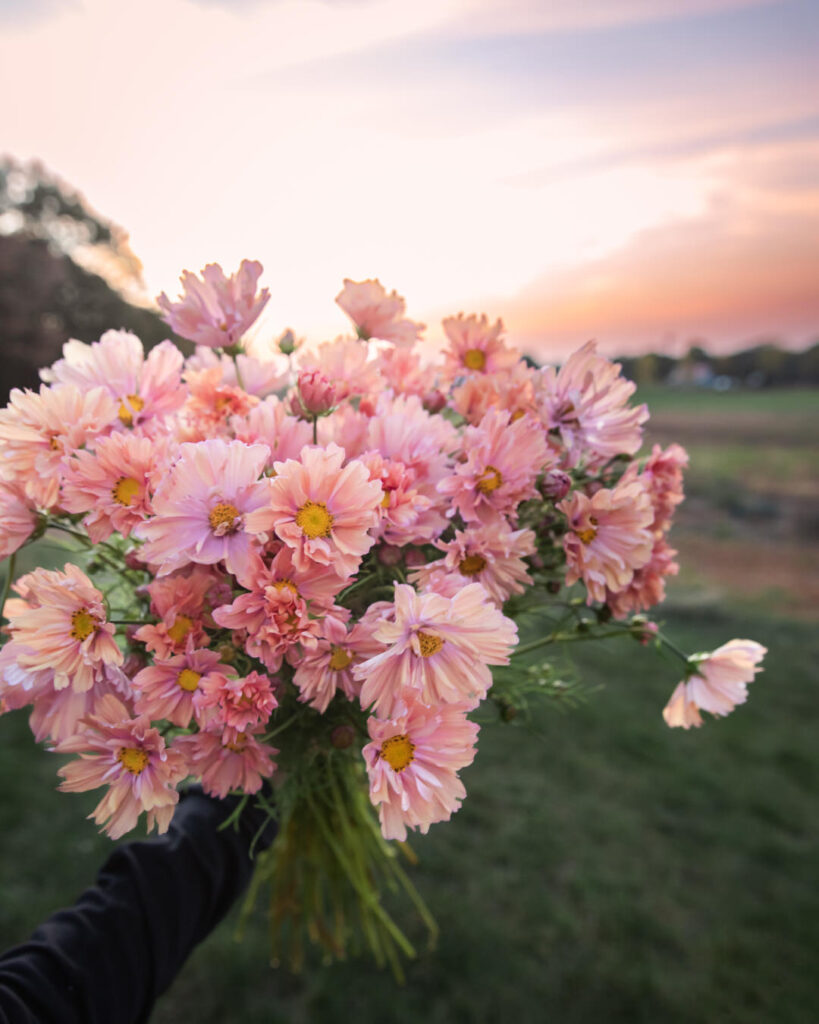
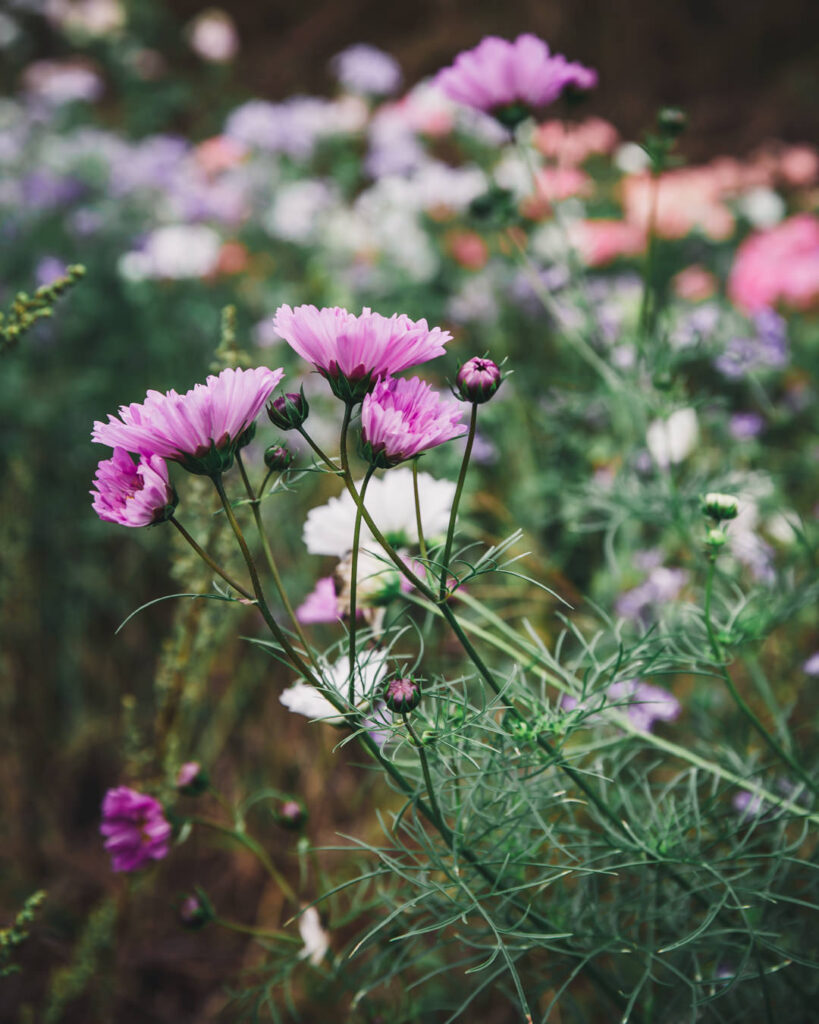
Propagation: N&B
Johnny’s recommends sowing into 50-cell plug flats or preferred seedling container 5–7 weeks before planting out, covering seeds lightly. Harden off and transplant out after danger of frost. Germination 7–10 days at 68–72F (20–22C). To direct seed: After last frost, once soil temperature is above 60F (16C), sow seed thinly in rows, barely covering the seeds (planting seeds too deeply will hinder germination). Keep soil consistently moist until seeds have germinated.
If you prefer soil blocks, Ziegler recommends 3/4-inch (2cm) blocks for cosmos. She prefers a slightly-higher soil temperature of 75F (24C), while SCF recommends 70–72F (21–22C).
Propagation: BTS
I’ve always grown our cosmos in 72-cell trays, but I am trying them in 50-cell trays to see if I notice a difference. I do not bump them up, they go straight into the field at this size.
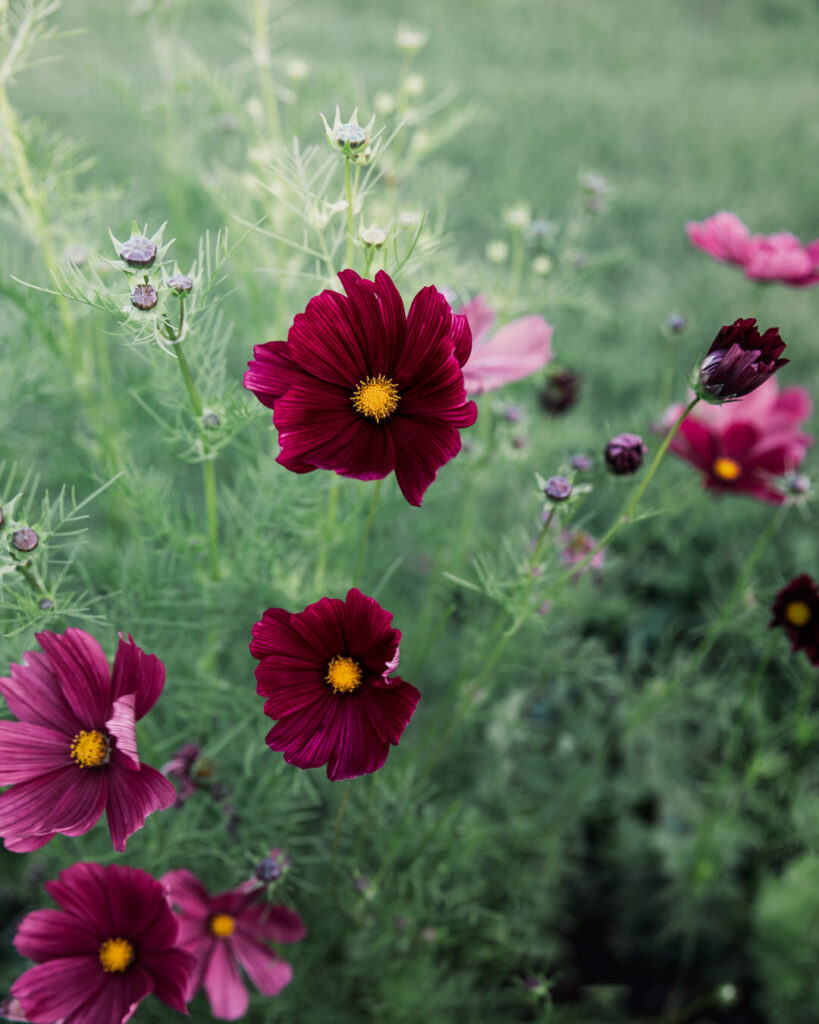
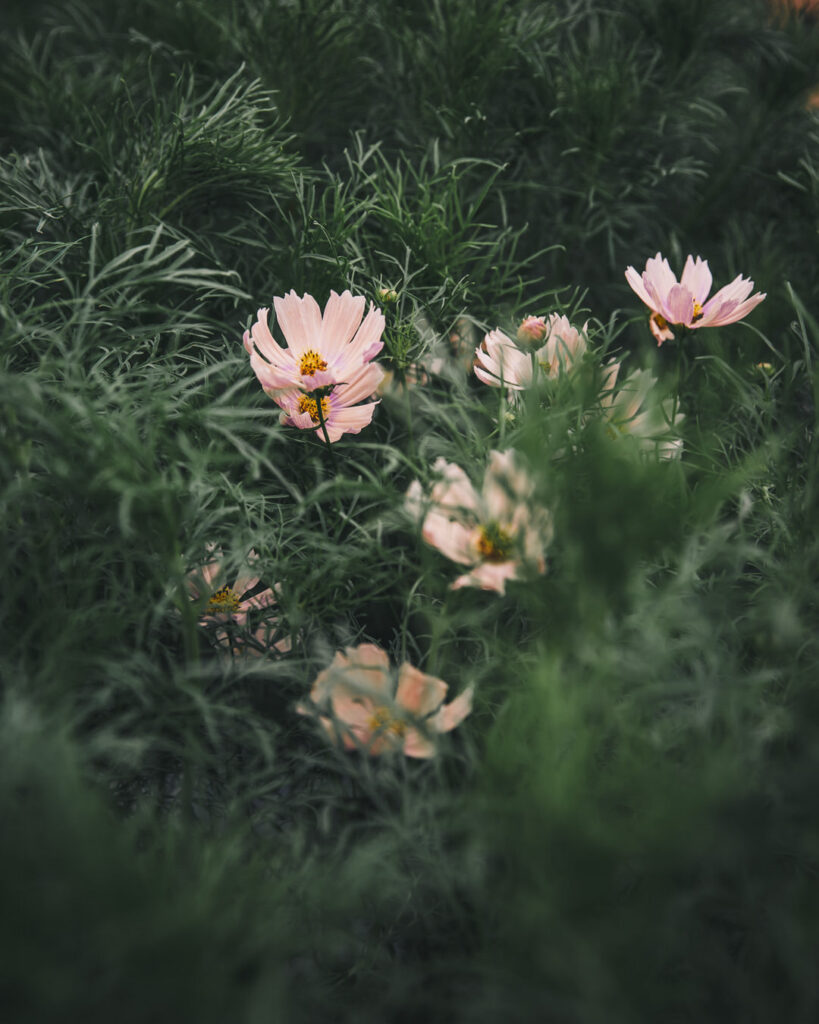
Environmental Factors: N&B
One of the most surprising environmental factors regarding cosmos, especially since it flowers in the summer, is that it’s actually a quantitative short-day plant. What this means is that the plants flower more rapidly under short days than under long days, but they eventually flower under all photoperiods (SCF).
When days are long (over 14 hours of light per day), plants are slower to bloom and the overall percentage of plants that produce flowers is decreased. Young plants are mostly affected by photoperiod, while mature plants will bloom regardless of photoperiod (Johnny’s).
So, for prolific plants, we should take photoperiod into consideration. Depending on climate, direct sowing in spring might be challenging if soil temperatures are not above 60F early enough in the season for the plants to mature. If they are not mature enough by early summer, they’ll be slow to bloom and not be as prolific. For this reason, it makes sense to start cosmos early indoors, because the plants will then be more mature by early summer and will bloom even when the days are still long.
Johnny’s suggests that by succession planting, you can produce a continuous supply of mature plants and therefore a continuous harvest throughout summer and into early fall, regardless of day length. Ziegler also recommends planning for a fall crop as the plants are extremely abundant as the days shorten.
Cosmos are heat-loving plants that prefer temperatures above 60F (16C). Temperatures below 55F (13C) inhibit growth and flowering (SCF; Johnny’s). Plants prefer full sun (minimum 8 hours).
Environmental Factors: BTS
Anecdotally, I’ve read that you can direct sow cosmos quite early in spring, so I thought I’d give it a try in 2023. While they germinated wonderfully and were certainly useable, they were not nearly as prolific as those started indoors from seeds. I think if your springs are mild, you may have a lot of luck with direct sowing (in fact, in warm climates they can be heavy re-seeders). However, for our short springs, I’ll stick with transplanting (until I can crack the code, ha).
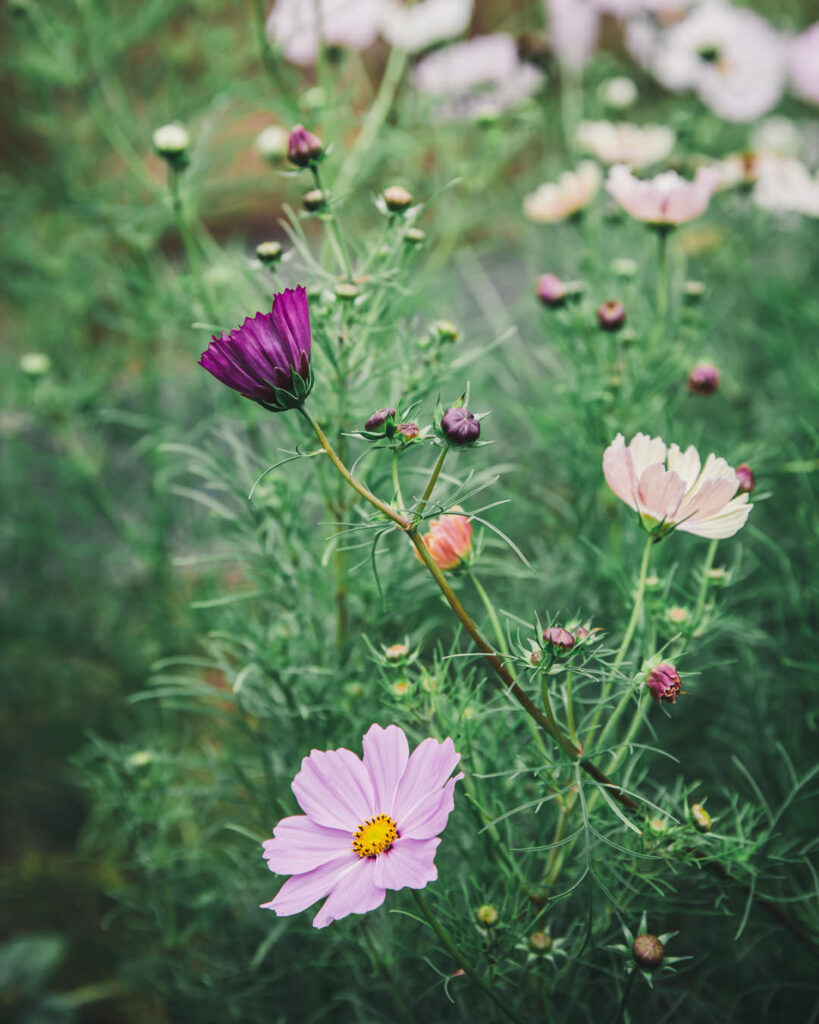
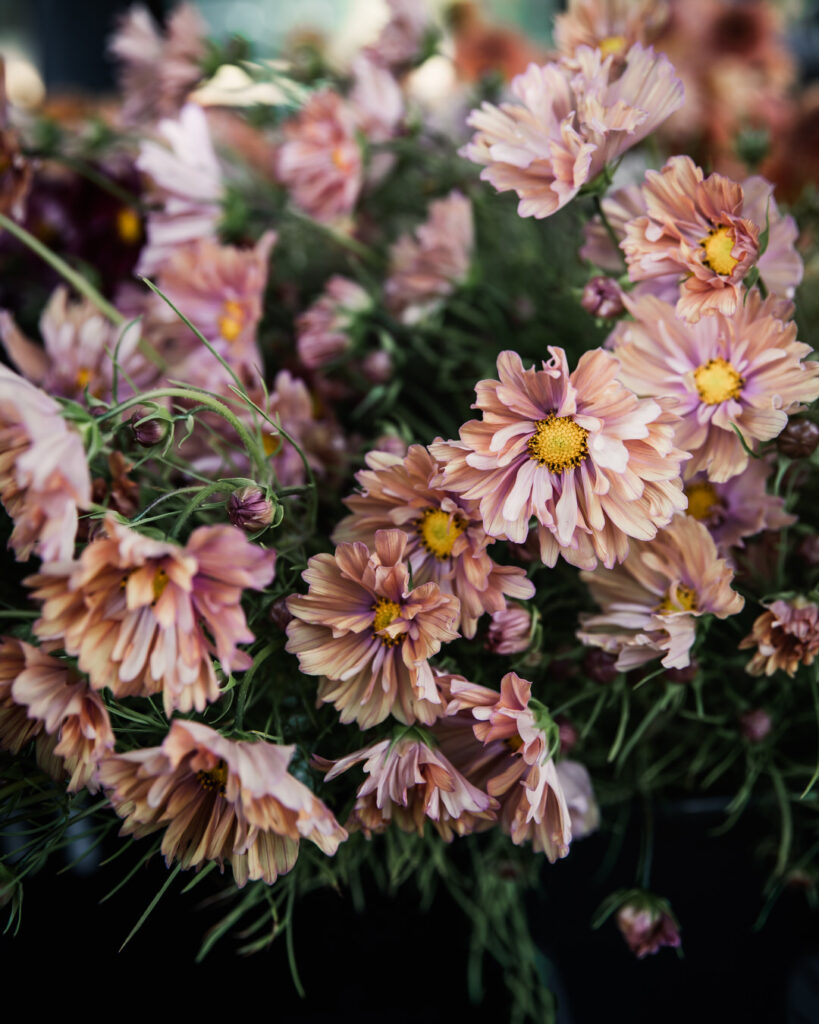
Transplanting, Spacing, Support: N&B
Transplant cosmos outdoors after the last frost and once plants have hardened off, 9–12″ apart. Wider spacing creates stronger, thicker stems (Johnny’s), though some growers report that plants can support themselves at 8″ spacing (SCF). Most sources, however, recommend support with either the corral method or hortonova netting.
Transplanting, Spacing, Support: BTS
We transplant our cosmos at 9–12″ spacing (just depends what bed they’re going in). I pretty much try and get away with not using netting whenever I can, but sometime the cosmos do tip over, so it’s recommended.
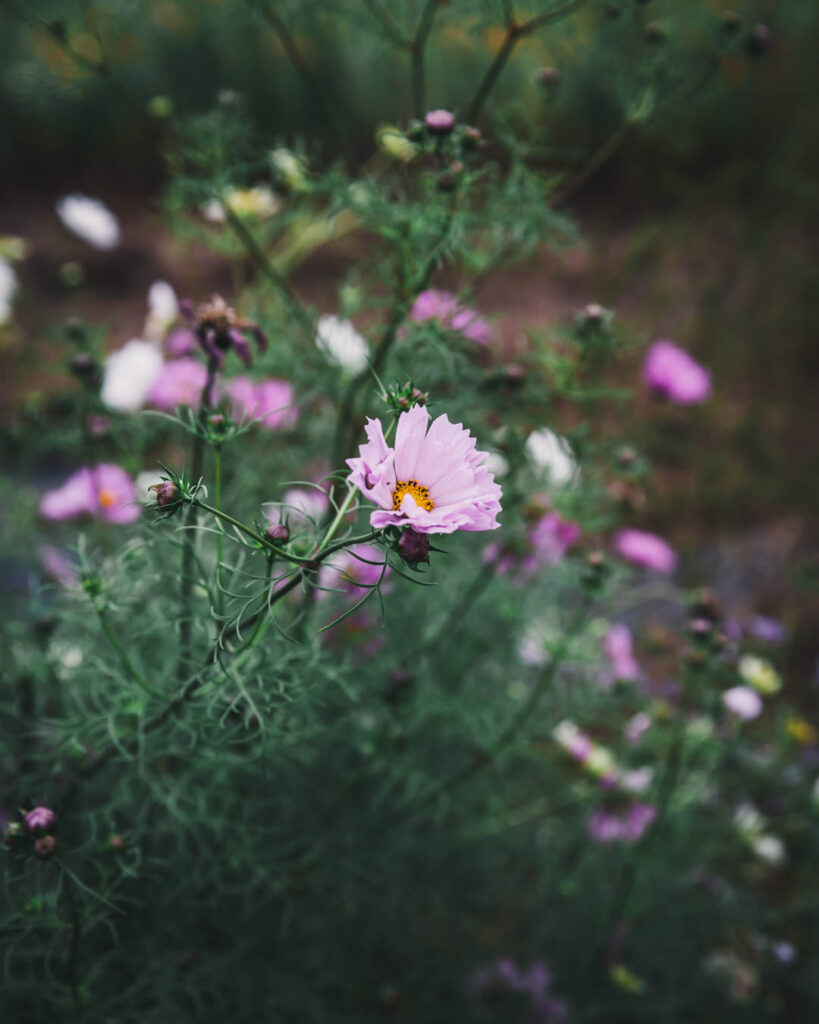
Successions: N&B
Johnny’s recommends the following:
“To ensure a long and productive harvest, you may wish to succession plant, starting with early spring plantings indoors, and staggering plantings at 14-day intervals. By succession planting, you can produce a continuous supply of mature plants and therefore a continuous harvest throughout summer and into early fall, regardless of day length.”
Ziegler prefers a smaller, early succession with 2 larger successions for the end of the season, because plants are more vigorous once the days shorten in fall.
Successions: BTS
Our season is so short that 1 to 2 successions of cosmos are all that we do (the plants keep cranking until frost for us).
Nutrition: N&B
Johnny’s, SCF, and Ziegler all warn against using too much fertilizer with cosmos, especially nitrogen, as it leads to plants with lots of foliage and few flowers. However, normal bed prep is fine (SCF recommends 10-10-10 in spring). In fact, cosmos thrive in nutrient-poor soil conditions! They are a great choice if your soil leaves a lot to be desired.
Nutrition: BTS
We fertilize our fields organically based on soil tests, and we do not fertilize for each crop individually. I have an eBook that outlines exactly how we do this. I’ve made that available for you here. A couple of seasons ago, I tried cosmos in our high tunnel (which has much better soil than the field). And while the plants were absolutely massive, they didn’t produce quite as many blooms as field grown. I’m guessing it’s because the fertility is much higher in this soil!
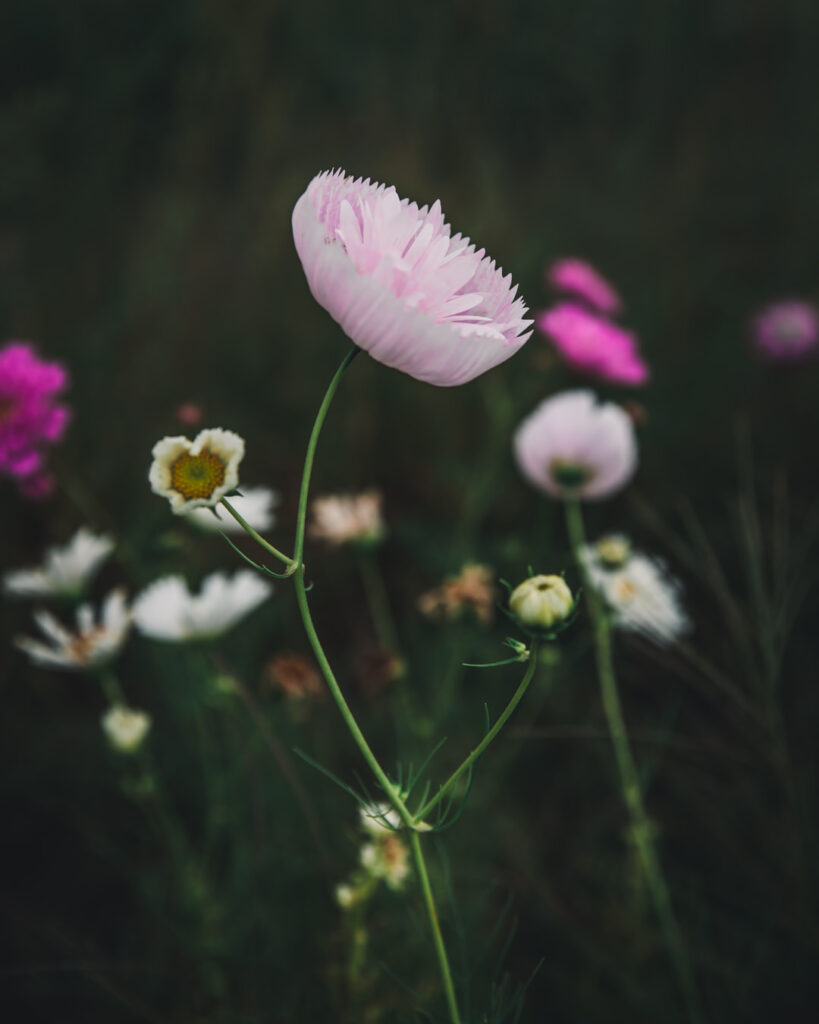
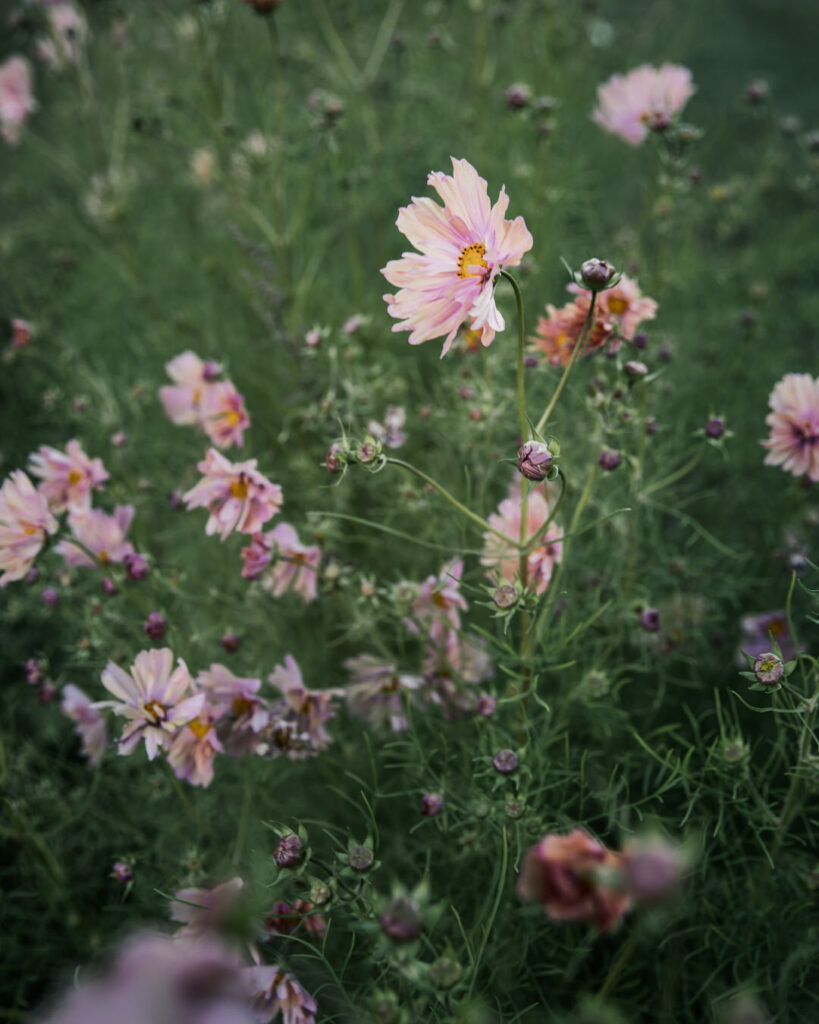
Drainage & Irrigation: N&B
Similar to fertilizer, once plants are established, do not overwater as it will also lead to a lot of foliage and not many blooms. Cosmos can tolerate dry conditions, even in the heat of summer.
Drainage & Irrigation: BTS
At our farm, we have gossil-loamy sand, meaning that our soil is more sand than loam. It actually drains excessively to the point of leaching nutrients. Our biggest difficulty is keep plants irrigated, especially in dry spells. For this reason, we do have drip irrigation installed on all of our beds at the home farm, but cosmos does not need as much water as other plants.
Pinching: N&B and BTS
To encourage longer, lateral stems, plants should be pinched. Some growers pinch out the central bud at seedling stage, while others wait until the plants are 18″ and cut them down to 10″ to 12″ (SCF). Pinch/deadhead expired blooms to keep plants producing.
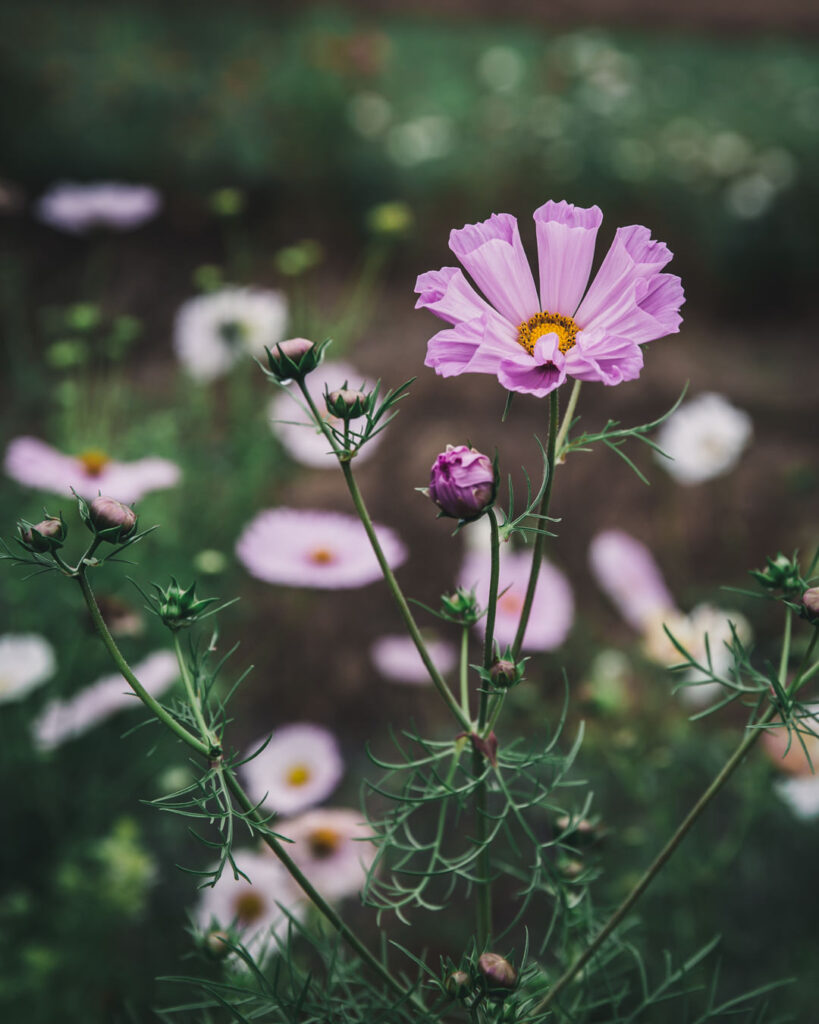
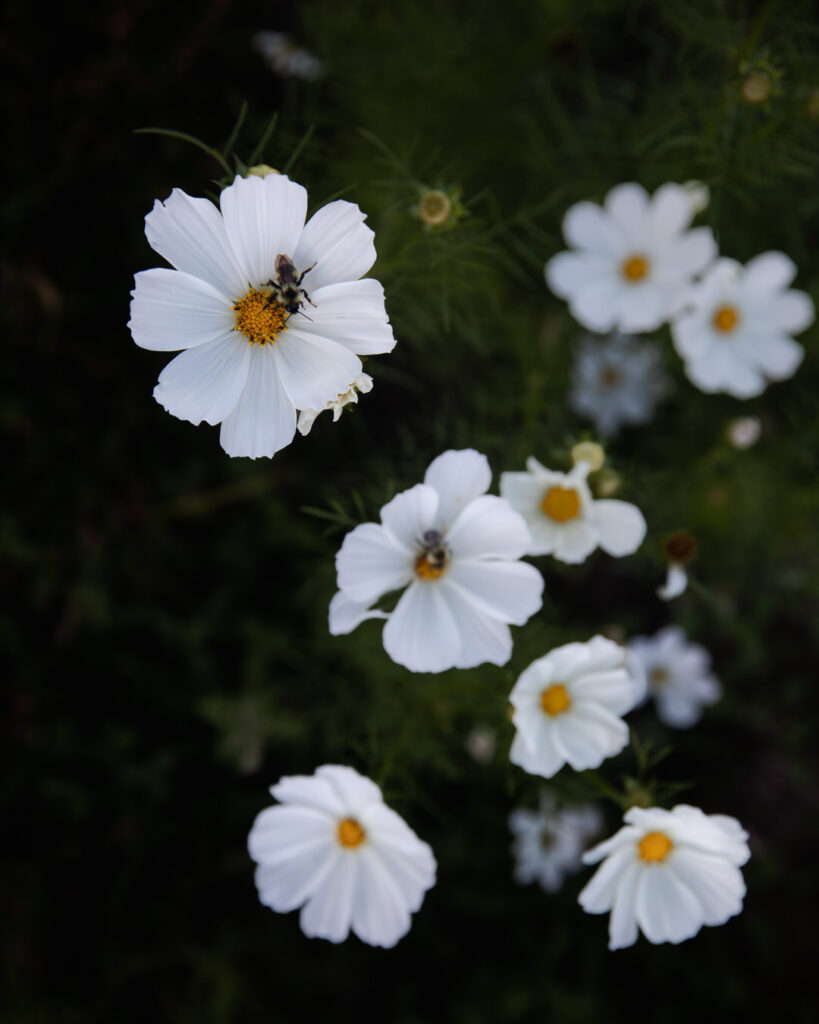
Bloom Period: N&B and BTS
Cosmos typically flower from summer through fall.
Overwintering: N&B and BTS
Cosmos are not typically overwintered, but in some warmer climates, they can be aggressive re-seeders. They’ll even occasionally re-seed here in Wisconsin!
Harvest & Post-Harvest: N&B
Harvest fresh flowers when the petals on the first flower are just opening, but not yet flattened. Cosmos can also be harvested in bud stage, when just about to open and colored. They will continue to open (Johnny’s; Postharvest Handling). Harvest cosmos often, even daily, to minimize deadheading and ensure older blooms are not harvested (they do not last long). Strip some foliage to help with rehydration, but cosmos foliage is also beautiful.
Expected vase life is 5 to 7 days. Postharvest Handling says that a holding preservative is essential, adding 2 to 3 days vase life. Stems can be stored for a week in water at 46F (2C), but vase life dropped dramatically at 2 weeks. Colder is better, as vase life also decreased when storage temperature increased from 36 to 44F (2 to 7C). NCSU trials found that ‘Double Click’ and ‘Versailles’ had a vase life of 5 to 6 days, while ‘Sonata’ Mix lasted 7 to 9 days.
Harvest & Post-Harvest: BTS
We harvest at the stages as recommended above (sometimes we catch some earlier than others) and use a holding solution. We don’t store much longer than a day or two in our cooler. Cosmos are somewhat tedious to harvest, but I really enjoy them otherwise, so they’re here to stay 🙂
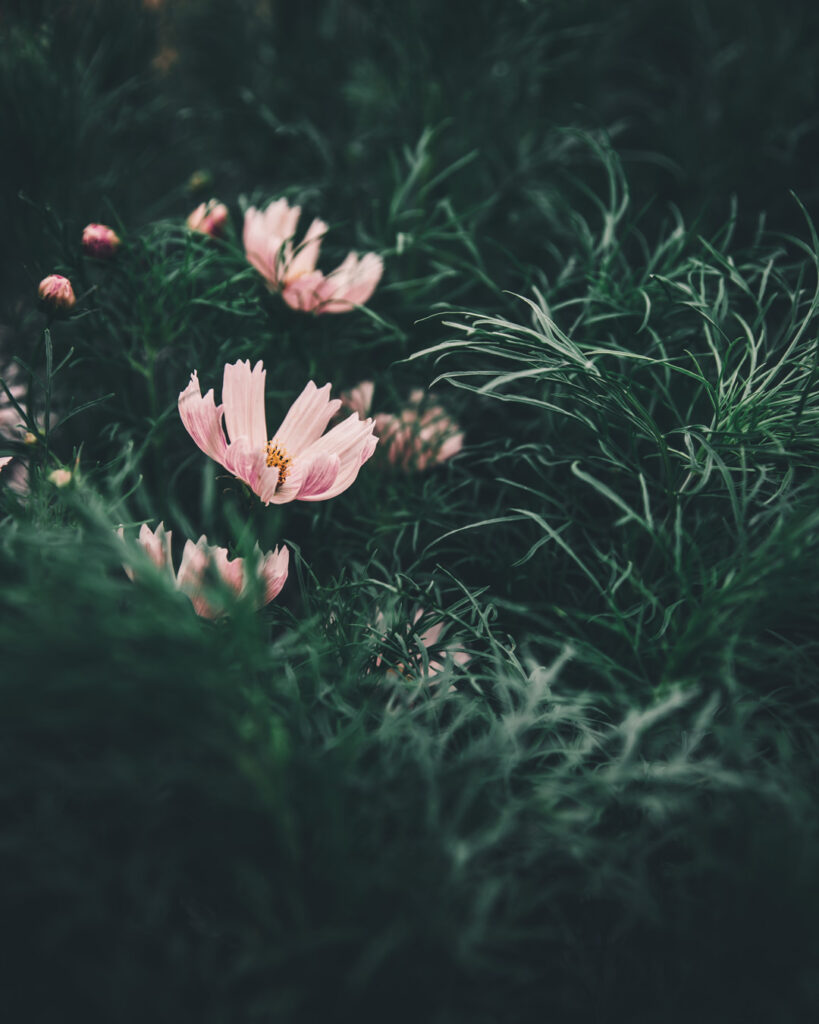
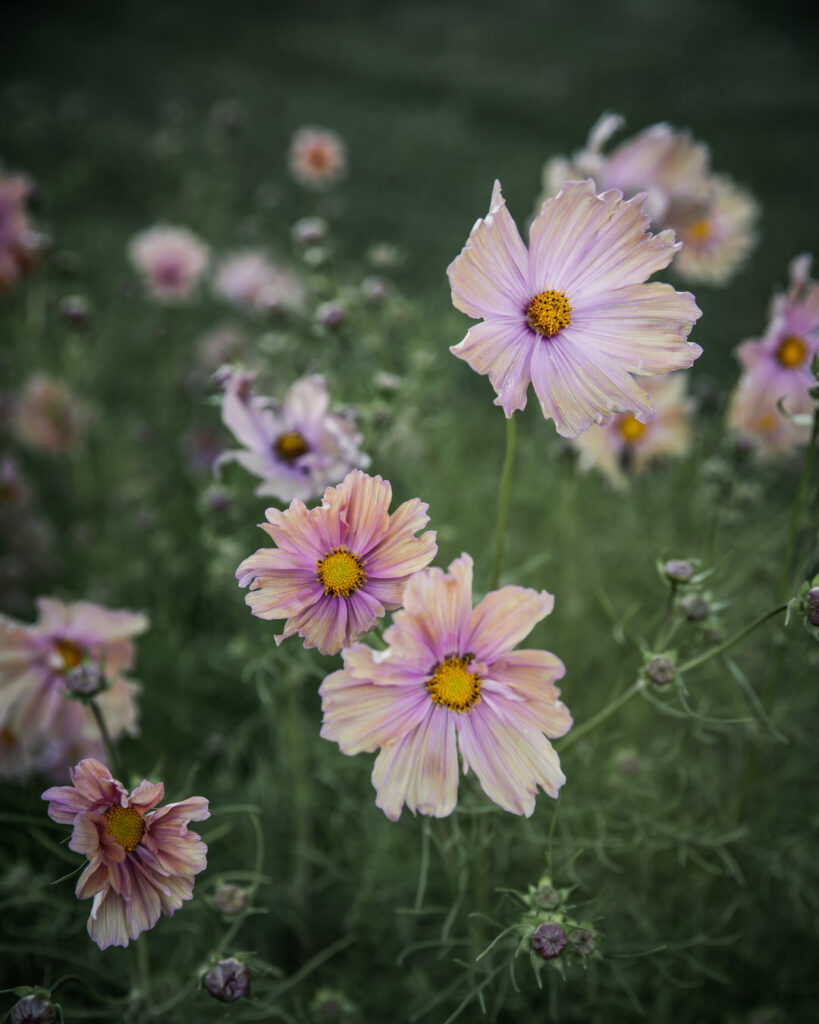
Pests & Disease: N&B
Cosmos are generally easy to grow and not particularly susceptible to pests and disease, but potential pests include aphids, Japanese beetles, and leafhoppers. Some diseases include bacterial and fungal root and stem diseases. For disease and pest control, see Johnny’s comparison chart.
Pests & Disease: BTS
We’ve never had any major issues with cosmos.
Variety Selection: N&B
Johnny’s and Floret both have great catalogs for perusing cosmos varieties. Typically, the apricot-colored cosmos are shorter plants, but Johnny’s recommends ‘Apricotta’, because it’s tall and vigorous (video here). They also recommend pairing it with ‘Rubenza.’ For ease of harvest, they recommend ‘Afternoon White’ for it’s tall, thick, and well-organized stems.
Variety Selection: BTS
While I’ve grown many cosmos over the years, my hands-down favorite varieties are ‘Afternoon White,’ ‘Apricotta,’ ‘Cupcakes Blush’, and ‘Rubenza.’ They all are prolific and bloom on tall stems that are easier to harvest. ‘Afternoon White’ for example, was specifically bred for cut-flower production, and as a tetraploid, it has more substantive flowers and stems. I also just love it’s vintage garden vibe. Similar to Johnny’s recommendation, ‘Apricotta’ beats ‘Apricot Lemonade’ all day. Though there are nuances in the color, I don’t feel it’s enough to warrant growing both. While there are numerous varieties worth trying, I find these grow best for us and cover all of our color palette needs.
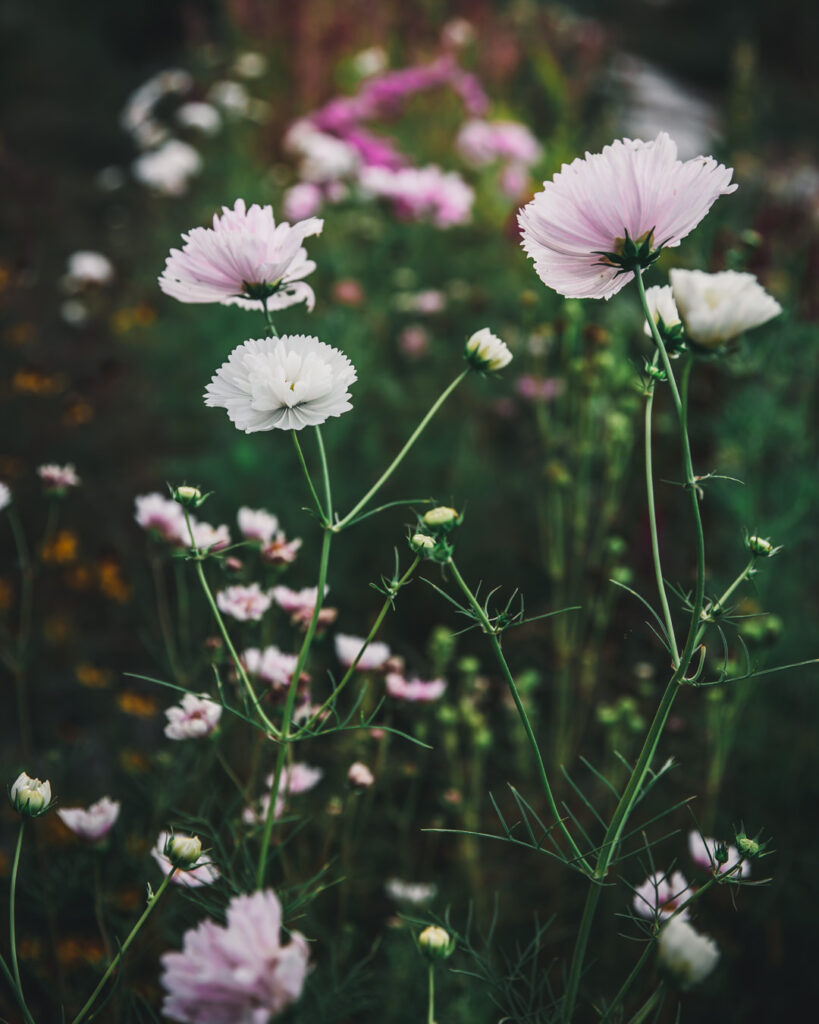
Pricing: N&B and BTS
BOSTON Ornamental Terminal Prices as of 04-AUG-2020:
COSMOS: OFFERINGS LIGHT. per bunch EC long 8.50
$10 is my florist price. I don’t typically sell cosmos by the bunch for retail.
Design: BTS only
I’ve always used cosmos in market bouquets, but it was after taking a design course with Gabriella Salazar that I became totally inspired to use them in design (see some inspiring photos here, here, here, here, here, I’ll stop now). But also, how cute is this table scape? And this (pretty sure those are Xanthos, which are super pretty but a little short). The blooms are so soft and have this floaty-dancing quality to them, and even the foliage is wispy and romantic!
Even though they are considered a filler flower, cosmos are easily one of our most-requested flowers are the farm by retail customers, florists, and BRIDES! We have seen such an uptick in bride requests for cosmos, it’s wild.



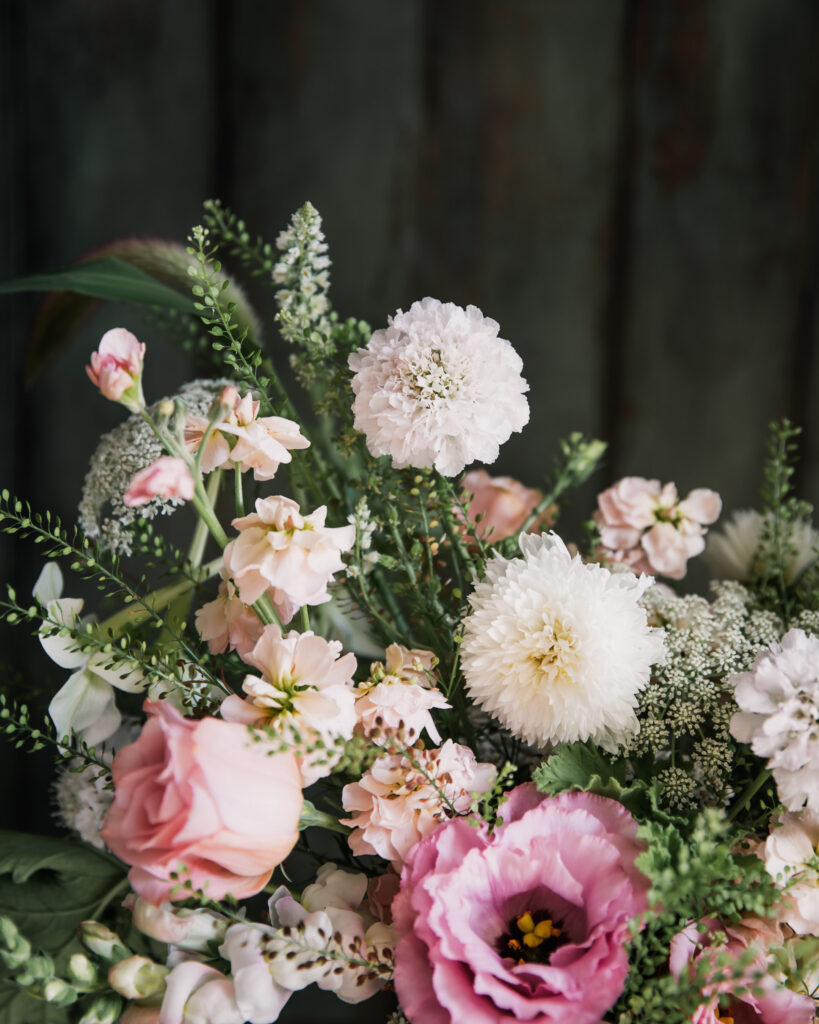

Wrap Up
OK, my friend, that is IT for this Plant Profile. What do you think? Did you find some useful nuggets? Be sure to save a PDF copy using the buttons below, so you can always refer back to it.
Have any questions or something you want to share with me or others? I know I say this ad nauseam, but I truly believe in the power of the collective and that we all have something unique and powerful to share, so please leave a question or share a comment below. We’re all better for it, and I thank you in advance!
Cheers pal!
cLICK FOR Comments +